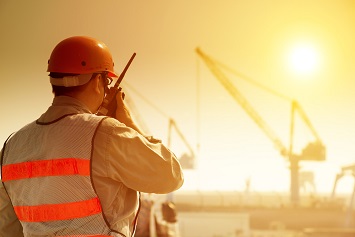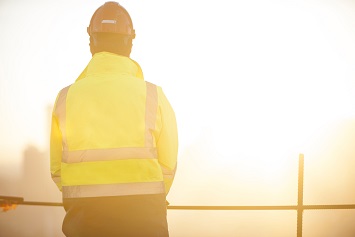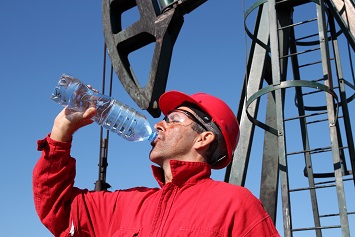Personal protective equipment (PPE) is vital to workplace safety, but it can also be uncomfortably hot—and warm weather doesn’t help. New research and products are looking to keep workers cool while wearing PPE without compromising on protection.
It’s been a hot summer—one for the record books. July 2019 edged out July 2016 to become the hottest month on record, according to the European Union’s Climate Change Service. June 2019 was the hottest June ever, the Climate Change Service reported.
If you have employees who must wear long pants and long-sleeved shirts or arc-flash and fire-resistant (AFR) clothing to protect them from other workplace hazards, the potential for heat stress is even greater.
Certain government and industry consensus standards require workers to wear AFR clothing. These garments aren’t optional no matter how tempted your employees may be to go without.
AFR clothing is impermeable and doesn’t allow effective heat exchange. Some outdoor workers must wear long pants and long-sleeved shirts to protect them from biting insects. Aren’t these workers sweltering in those clothes?
You may have seen high-tech “personal air-conditioning” devices recently covered in online news or on television. Sony has a smartphone-operated personal air-conditioning system it plans to release in time for the 2020 Tokyo Summer Olympic Games. A group of entrepreneurs from the Massachusetts Institute of Technology is selling a $300 cooling bracelet that is also smartphone-enabled. Could something like those help?
Consumer personal air-conditioning devices like the Sony Reon Pocket and Embr Labs’ Embr Wave bracelet aren’t intended for the personal protective equipment (PPE) market.
However, safety equipment suppliers offer a variety of cooling garments that can be used with impermeable protective clothing.
For example, Cincinnati, Ohio-based Vortec makes a personal air-conditioning vest for the PPE market. Vortec’s personal cooling vest consists of a:
- Cooling tube with belt that pumps cold compressed air to provide air flow to the worker; and
- Plasticized PVC vest through which the cold air flows to cool the worker’s torso.
Vortec claims its personal air-conditioning vest is capable of keeping the wearer 45°F to 60°F cooler than the ambient air temperature, minimizing worker heat stress and reducing the frequency and duration of cooling breaks.
NIOSH Research
The National Institute for Occupational Safety and Health (NIOSH) studied the use of cooling PPE in its 2016 recommendation for a standard for heat and hot environments. They found cooling PPE can help mitigate the heat caused by wearing protective clothing or equipment but that there are limitations for each type of cooling garment.
Protective clothing like AFR clothing can add to the heat stress of summer work, and workers may be tempted to go without it. AFR clothing protects workers from sparks but makes body-temperature regulation difficult.
All clothing, but especially clothing developed to provide protection against hazardous chemical, physical, and biologic agents, will affect the rate and amount of heat exchange between the skin and the ambient air. Clothing insulates the wearer from the external environment and also traps body heat.
Wearing impermeable, protective clothing greatly limits heat exchange. The impermeability prevents the evaporative heat transfer normally accomplished through sweating. Wearing and working in protective clothing, which sometimes can be heavy, also requires additional metabolic energy, creating even more body heat.
PPE That Cools
NIOSH evaluated four auxiliary cooling methods for its heat and hot environments criteria document:
- Water-cooled garments,
- Air-cooled garments,
- Cooling vests, and
- Wetted overgarments.
Water-cooled garments have coolant tubing sewn into the garment and an external operating device. The operating device may include a battery, circulating pump, control pad, fluid container, and heat exchanger. However, the weight and volume of the operating device may limit a wearer’s movement and impose an extra weight burden. A water-cooled garment includes:
- Water-cooled cap paired with a water-cooled vest,
- Long water-cooled undergarment, and
- Short water-cooled undergarment.
Because water-cooled systems require the wearer to be tethered to a system to circulate cool water through the garment, they also limit the range of operation.
Air-cooled garments distribute cooling air next to the skin. Garments like the Vortec personal air-conditioning vest use a vortex tube as a source of cooled compressed air and require a constant source of compressed air supplied through an air hose. A vortex tube cooling system can be quite noisy but can be used in a variety of hot environments.
Cooling vests may contain as many as 72 cooling packs made of ice or frozen phase-change materials. Cooling packs are secured to the vest by tape inserted into vest pockets or integrated with the vest. The last type requires freezing the entire vest before each use.
Ice packs and packs containing frozen phase-change materials quickly unfreeze, limiting their usefulness.
A cooling vest may only be effective for 2 or 3 hours. This requires replacing cooling packs every 2 to 4 hours. The cooling pack replacement requires a work stoppage to swap out cooling packs. Cooling pack garments are noise-free, require no external apparatus, are less expensive than any other garment type, and allow for greater mobility than any of the other methods.
A wetted overgarment consists of a wetted cotton terry cloth coverall or a two-piece cotton cover, extending from just above the boots and from the wrists to a V-neck. The wetted overgarment provides a simple cooling method, effective in cooling a worker in impermeable clothing. However, because the method relies on evaporative cooling, it works best in low-humidity, high-temperature environments.
Cooling garments can also be too heavy for some work assignments or tasks.
PPE: Last Resort
You should also remember that PPE of any type, including cooling garments, is a last resort. PPE typically is the least-effective control measure. The traditional hierarchy of controls is elimination of hazards, then substitution, engineering controls, administrative controls, and then PPE.
The most widely recommended and used controls for heat stress and illness are administrative controls.
NIOSH’s recommendation for a federal heat and hot environments standard is a good guide to control methods for heat stress. NIOSH suggests reducing the length of time and temperature workers are exposed to in heat stress conditions by taking the following steps:
- Schedule hot tasks for cooler parts of the day, such as early morning, late afternoon, or the night shift; or schedule hot tasks on alternate rather than successive days;
- If you can, schedule occasional, routine maintenance and repair work in hot areas for cooler seasons of the year;
- Alter rest and work schedules to permit more rest time; or
- Add extra personnel to reduce exertion levels and exposure time for each member of the crew.
Increasing crew sizes can mitigate the exertion required from each worker. The level of exertion contributes to heat stress. Clothing, exertion, humidity, and temperature, as well as duration of exposure all are factors in heat stress.
Work schedules and crew size can help reduce but do not eliminate heat stress. You will need to provide breaks, shade, and water to prevent heat-related illnesses.
However, you can enhance your employees’ ability to work in hot conditions through a heat-acclimatization program. Keep in mind that the ability of people to adapt to heat varies widely.
A properly designed and applied heat-acclimatization program will increase your employees’ ability to work in hot conditions and decrease the risk for heat-related illnesses, as well as help prevent unsafe acts caused by diminished judgment or mental capacity due to heat.
The armed forces and other government researchers have found heat acclimatization can usually be accomplished over 7 to 14 days of increased exposure to hot conditions.
For workers who have had previous exposure to hot conditions on the job, the acclimatization regimen should start at no more than 50 percent of the usual duration of work in the hot environment on day 1, 60 percent on day 2, 80 percent on day 3, and then 100 percent on day 4.
For new workers, the schedule should begin with no more than 20 percent of the usual duration of work in the hot environment on day 1, and increase by no more than 20 percent each day.
Being physically fit does not replace the need for heat acclimatization but can enhance heat tolerance. The time required for non-physically fit individuals to develop acclimatization is about 50 percent greater than for the physically fit.
An adequate water supply and intake are essential for heat tolerance and for the prevention of heat-related illnesses. The water lost in the sweat and urine must be replaced at least hourly during the workday.
Education and Training
Workers and supervisors should be trained in the prevention and first aid of heat-related illness, as well as how to recognize symptoms of heat stress and heat-related illness—including heat cramps, heat exhaustion, heat rash, and heatstroke—in themselves and others.
A buddy system should be implemented in which each worker and supervisor on a hot job is responsible for one or more other workers. Each should be assigned the responsibility for observing, at periodic intervals, one or more fellow workers to determine whether they have any early symptoms of a heat-related illness.
Any worker who exhibits signs and symptoms of an impending heat-related illness should be sent to the first-aid station for a more complete evaluation and possible first-aid treatment.
Heatstroke, the most serious of heat-related illnesses, can be fatal if treatment is delayed. Signs and symptoms of heatstroke can include confusion or altered mental status, slurred speech, seizures, or loss of consciousness.



